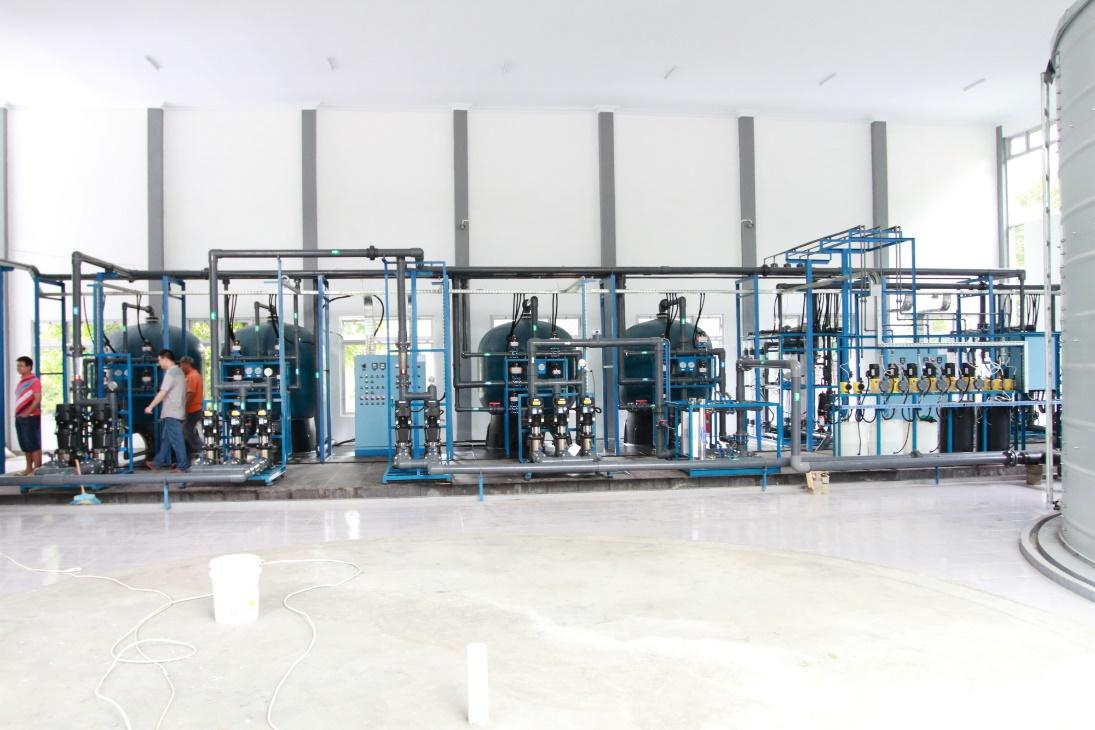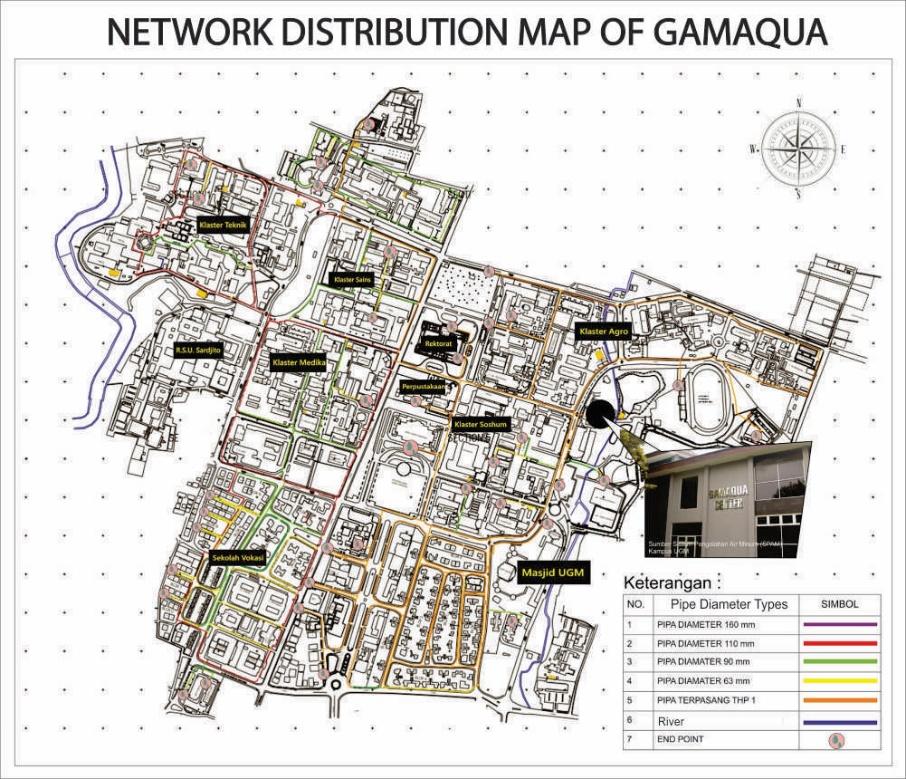The consumption of treated water at UGM comes from 2 sources, namely SPAM (Drinking Water Supply System) Campus which is also called Toya Gama which is processed at Gamaqua Center and PDAM, but only 3 buildings use PDAM. The use of clean water at UGM is 876,556 m3/year. To meet these needs, UGM has
several sources of water from deep wells, shallow wells, and groundwater tanks. Map of Clean Water Source Distribution in UGM is shown in Fig. 1. Groundwater tanks are located in several faculties shown in Fig.2((a) Faculty of Biology; (b) UGM’s main office; (c) Faculty of Psychology ( > 61 units); (d) Faculty of Cultural Science ( > 50 units); (e) Faculty of Agricultural Technology; (f) Library of UGM; (g) Faculty of Medicine, Public Health and Nursing; (h) Faculty of Dentistry). In addition, the following faculties also have rainwater tanks, namely Faculty of Biology (Fig. 3a); Library of UGM (Fig. 3b); UGM Residence (Fig. 3c); UGM Residence (Fig. 3d), Laboratory of Environmental Engineering (Fig. 3e), Department of Civil Engineering and Environmental Engineering (Fig. 3f). UGM also has a stormwater retention (Fig. 4) and water reservoir (Fig. 5) in Wisdom Park UGM.
Water Treatment from Water Source to Water Tank strat from raw water is pumped using the intake pump to enter the production stage. This production phase consists of three stages; Pre treatment, Ultrafiltration and Ultraviolet stages. The raw water that has been filtered by the Sand Filter and Carbon Filter is then stored into the Feed Tank and referred as feed water. The feed water is then pumped by the UF Feed Pump towards the Automatic Cleaning Filter (ACF) and passed into the Ultrafiltration system. Besides being processed, feed water is also used for the Sand Filter cleaning process which is often known as Sand Filter Backwash. The process illustration can be seen in Figure 6.
Pre-treatment
Raw water will enter the pre-treatment stage in the form of filtering through sand filters and proceed with carbon filters both are installed parallel before then the water enters the feed tank, which is then called feed water. Sand filter serves to filter out dirt particles in the water. Impurities in the form of colloids will be retained in the form of a gelatin layer. While ions dissolved in water will be neutralized by quartz sand ions. Then the water will experience neutralization. In addition, zoogleal layers of sand containing living organisms will eat organic matter and clean water. Thus, the way the quartz sand filter works can be mechanically, electrolysis and bactericidal.
Ultrafiltration
After the pretreatment stage, water will enter the feed tank and so it is called feed water. The feed water will then be filtered through Ultrafiltration. This Ultrafiltration filter is a very small filter to the nanoscale. The incoming water feed will be filtered on Ultrafiltration and then pumped to the ultraviolet.
Ultraviolet process
After Ultrafiltration, water will be scanned through ultraviolet waves to kill bacteria or viruses that escape Ultrafiltration. After going through Ultraviolet, water is referred to as product water or drinking water and is stored in a drink tank, which will then be distributed to UGM.
The treated water is then distributed at UGM as shown in Fig. 8. Treated water is also distributed to the Drinking water supply system in UGM (Fig. 9). Drinking water supply system in UGM includes a water tap (Fig. 10), water fountain (Fig. 11) and water dispenser (Fig. 12). Water fountain is available in 50 points and scattered across the area of Universitas Gadjah Mada. This facility is available for free, every academic and every person residing in the campus can use the water fountain for drinking water. The water produced by a water dispenser can be cold, warm or hot water. The presence of a water dispenser makes it easier for
The treated water is then distributed at UGM as shown in Fig. 8. Treated water is also distributed to the Drinking water supply system in UGM (Fig. 9). Drinking water supply system in UGM includes a water tap (Fig. 10), water fountain (Fig. 11) and water dispenser (Fig. 12). Water fountain is available in 50 points and scattered across the area of Universitas Gadjah Mada. This facility is available for free, every academic and every person residing in the campus can use the water fountain for drinking water. The water produced by a water dispenser can be cold, warm or hot water. The presence of a water dispenser makes it easier for students to obtain cold until warm water in a healthy freeway. Maps of Water Fountain and Water Dispenser in UGM is shown in Fig. 13
Additional evidence link: https://residence.ugm.ac.id/spam/
Figure 1 Map of Clean Water Source Distribution in UGM

Figure 2 Ground Water Tank in several faculties








Figure 3 Rain Water System in several faculties






Figure 4 Water retention in Wisdom Park UGM

Figure 5 Water reservoir in Wisdom Park UGM

Figure 6 Water Treatment from Water Source to Water Tank


Figure 7 Water Consumption Installation in UGM (Toya Gama)

Figure 8 Map of Gamaqua Distribution

Figure 9 Drinking Water Supply System

Figure 10 Water Tap

Figure 11 Water Fountain

Figure 12 Water Dispenser

Figure 13 Maps of Water Fountain and Water Dispenser in UGM

